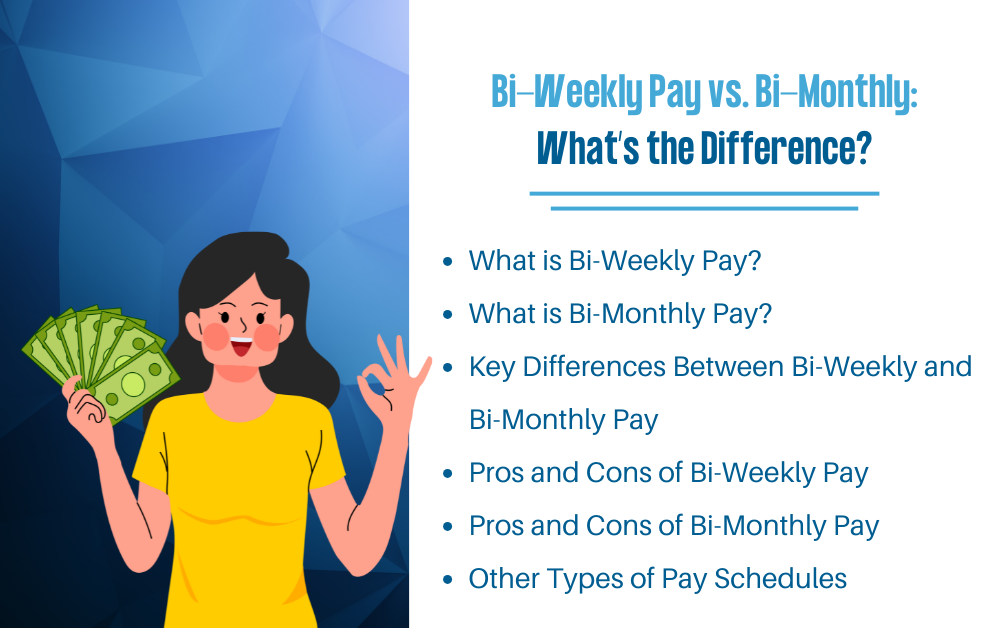When it comes to employee compensation, understanding pay schedules is crucial for both employees and employers. Two common options are bi-weekly pay and bi-monthly pay, but the differences between these schedules can significantly impact budgeting, payroll processing, and employee satisfaction.
This blog dives into the distinctions between bi-weekly and bi-monthly pay, outlining their pros and cons to help you make an informed decision. We’ll also touch on other pay schedules, such as weekly and monthly pay, to give you a full picture of the options available.
What is Bi-Weekly Pay?
Definition of Bi-Weekly Pay
Bi-weekly pay is a schedule where employees are paid every two weeks on the same day, such as every other Friday. This results in 26 pay periods per year, as there are 52 weeks in a year.
How It Works
- Frequency: Employees receive a paycheck every two weeks, typically totaling two paychecks per month. However, two months each year will have three paychecks.
- Example: If payday falls on a Friday, the next paycheck will arrive two Fridays later. Over time, this creates consistent pay intervals.
Impact on Budgeting
Because of its regularity, bi-weekly pay is easy to track for budgeting purposes. Employees can align their weekly expenses, such as groceries or gas, with their paycheck cycle.
What is Bi-Monthly Pay?
Definition of Bi-Monthly Pay
Bi-monthly pay, also called semi-monthly pay, means employees are paid twice per month, usually on set dates like the 1st and 15th or the 15th and the last day of the month. This results in 24 pay periods per year.
How It Works
- Frequency: Employees receive two paychecks per month, regardless of the number of weeks.
- Example: A paycheck might arrive on the 15th and the 30th of each month. For shorter months, like February, paydays may be adjusted accordingly.
Impact on Budgeting
Bi-monthly pay aligns well with fixed monthly expenses, such as rent, utilities, or loan payments. However, it may require employees to adjust their weekly budgeting due to the variability of days between paychecks.
Key Differences Between Bi-Weekly and Bi-Monthly Pay
Number of Pay Periods
- Bi-Weekly Pay: Employees receive 26 paychecks per year because they are paid every two weeks.
- Bi-Monthly Pay: Employees receive 24 paychecks per year as they are paid twice per month.
Payday Consistency
- Bi-Weekly: Payday falls on the same day of the week (e.g., every other Friday).
- Bi-Monthly: Payday falls on specific dates (e.g., the 1st and 15th), which may land on weekends or holidays, causing potential delays.
Paycheck Size
Since bi-monthly pay divides the same annual salary into fewer pay periods, each paycheck is slightly larger than a bi-weekly paycheck. However, bi-weekly pay provides two extra checks per year, which can feel like a bonus during those months.
Overtime and Hourly Work
- Bi-Weekly: Overtime for hourly workers is calculated based on two-week periods, often leading to a more straightforward computation.
- Bi-Monthly: Overtime calculations can vary because pay periods do not always align with calendar weeks.
Pros and Cons of Bi-Weekly Pay
Pros of Bi-Weekly Pay
- More Frequent Paychecks: Employees are paid more often, which helps with weekly budgeting.
- Easier for Hourly Workers: Aligns well with standard workweeks, making overtime and hours easier to track.
- Predictable Schedule: Paydays consistently fall on the same day of the week.
Cons of Bi-Weekly Pay
- Extra Pay Periods: Two months each year will have three paychecks, which can complicate payroll processing and budgeting.
- Payroll Processing Costs: Employers face higher administrative costs due to more frequent payroll runs.
- Alignment with Monthly Expenses: Employees may need to adjust their budgeting if bills are due monthly.
Pros and Cons of Bi-Monthly Pay
Pros of Bi-Monthly Pay
- Aligns with Monthly Bills: Since paychecks arrive twice a month, it’s easier to sync income with monthly expenses like rent, utilities, or loans.
- Fewer Payroll Runs: Employers only process payroll 24 times a year, reducing administrative costs.
- Larger Paychecks: With fewer pay periods, each paycheck is slightly larger compared to bi-weekly pay.
Cons of Bi-Monthly Pay
- Variable Paydays: If a payday falls on a weekend or holiday, employees may have to wait until the next business day for their paycheck.
- Inconsistent Weekly Budgeting: Employees must manage uneven gaps between paydays, especially when transitioning from bi-weekly pay.
- Overtime Complexity: Calculating overtime can be trickier as pay periods do not align with standard workweeks.
Other Types of Pay Schedules
Weekly Pay
- Definition: Employees are paid every week, resulting in 52 paychecks per year.
- Industries: Common in retail, hospitality, and construction.
- Pros:
- Frequent paychecks help with immediate financial needs.
- Ideal for hourly workers with fluctuating hours.
- Cons:
- High payroll processing costs for employers.
- Employees receive smaller, more frequent payments.
Monthly Pay
- Definition: Employees are paid once a month, resulting in 12 paychecks per year.
- Industries: Common in executive and contract work.
- Pros:
- Simplifies employer payroll processing.
- Larger paychecks can help with long-term budgeting.
- Cons:
- Long gaps between paychecks can be challenging for employees.
- Requires careful budgeting to avoid running out of funds before the next payday.
Daily or On-Demand Pay
- Definition: Employees are paid daily or can access their earnings as they work (on-demand pay).
- Industries: Often used in gig work, freelancing, or temporary staffing.
- Pros:
- Provides immediate access to earned wages.
- Helps employees manage unexpected expenses.
- Cons:
- May encourage overspending or lack of long-term financial planning.
- Requires robust payroll systems to handle frequent payments.
Choosing the Right Pay Schedule for Your Needs
Understanding the differences between bi-weekly and bi-monthly pay is essential for both employers and employees. Each schedule offers unique advantages and challenges, from the consistency of bi-weekly paychecks to the alignment of bi-monthly pay with monthly expenses.
When deciding on a pay schedule, consider factors like industry standards, employee preferences, and administrative costs. By choosing the right system, businesses can improve employee satisfaction and streamline payroll processes.
Additionally, exploring other pay schedules, such as weekly or monthly pay, can help organizations find the best fit for their workforce.
Optimize Your Payroll System Today
Whether you’re an employer looking to refine your payroll strategy or an employee seeking clarity on your pay schedule, understanding these options can help you make better financial decisions. For employers, consider partnering with a payroll service provider to streamline your processes and ensure compliance with regulations.
Ready to take the next step? Contact BCM Payroll to learn how we can help optimize your payroll system and improve employee satisfaction.

